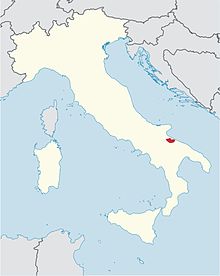Roman Catholic Diocese of Andria
|
Diocese of Andria Dioecesis Andriensis |
|
|---|---|

|
|
| Location | |
| Country | Italy |
| Metropolitan | Bari-Bitonto |
| Statistics | |
| Area | 799 km2 (308 sq mi) |
| Population - Total - Catholics |
(as of 2015) 141,229 140,000 (est.) (99.1%) |
| Information | |
| Rite | Latin Rite |
| Established | 11th Century |
| Cathedral | Cattedrale di S. Maria Assunta |
| Patron saint | Richard of Andria |
| Secular priests | 69 (diocesan) 20 (religious Orders) |
| Current leadership | |
| Pope | Francis |
| Bishop | Luigi Mansi |
| Map | |
 |
|
The Italian Catholic diocese of Andria is in Apulia, seated at Andria Cathedral, about ten miles southwest of Trani. It is a suffragan of the archdiocese of Bari-Bitonto. The diocese has 39 parishes, with one priest for every 1,573 Catholics.
Tradition assigns the Christian origin of Andria to an Englishman, St. Richard, chosen as bishop by Pope Gelasius I, about 492 AD. The story has been dismissed as fable by some scholars. A Bishop Christopher of Andria is reported at the II Council of Nicaea in 787, but inspection shows that he was Christopher Bishop of Saint Cyriacus (Gerace).
The diocese dates probably back to the time of Gelasius II, elected Pope in 1118. The earliest known bishop of Andria, whose name is not preserved, took part in the translation of the body of S. Nicolas Peregrinus in Trani in 1143. Bishop Richard of Andria was present at the Eleventh Ecumenical Council (Third Lateran, 1179) held under Pope Alexander III.
It was united with the diocese of Montepeloso, from 1452 to 1479.
Erected: 11th Century
Latin Name: Andriensis
Metropolitan: Archdiocese of Trani
United: 1452 with the Diocese of Montepeloso
Latin Name: Andriensis-Montis Pelusii
Split: 1479 into the Diocese of Andria and the Diocese of Montepeloso
Latin Name: Andriensis
![]() This article incorporates text from a publication now in the public domain: Herbermann, Charles, ed. (1913). "Andria". Catholic Encyclopedia. New York: Robert Appleton.
This article incorporates text from a publication now in the public domain: Herbermann, Charles, ed. (1913). "Andria". Catholic Encyclopedia. New York: Robert Appleton.
...
Wikipedia
